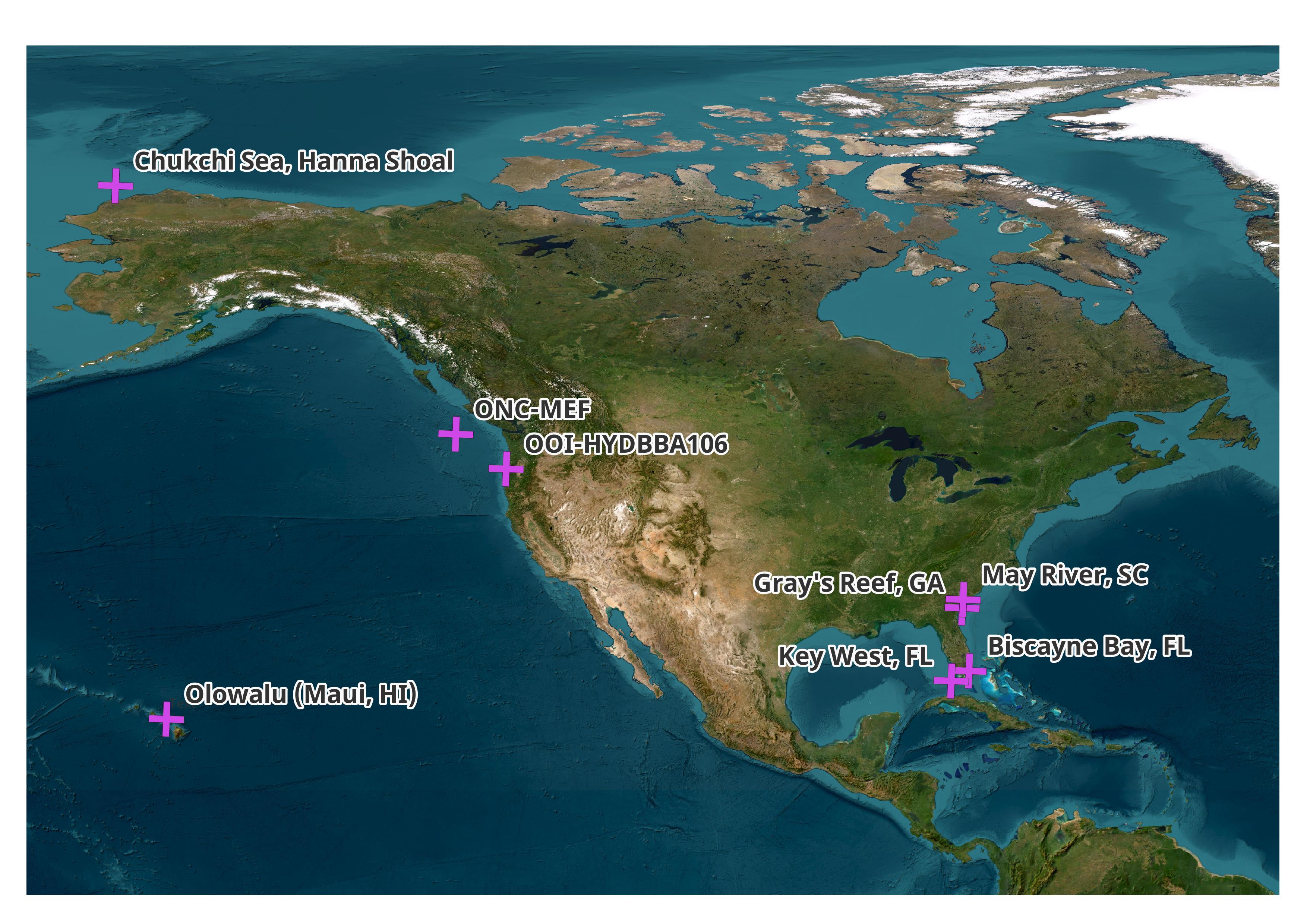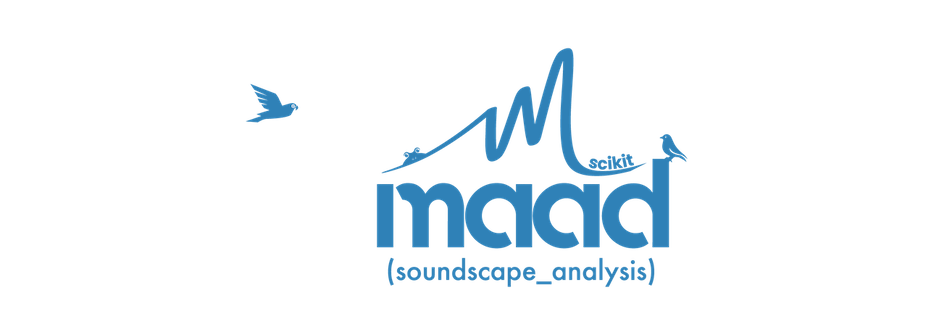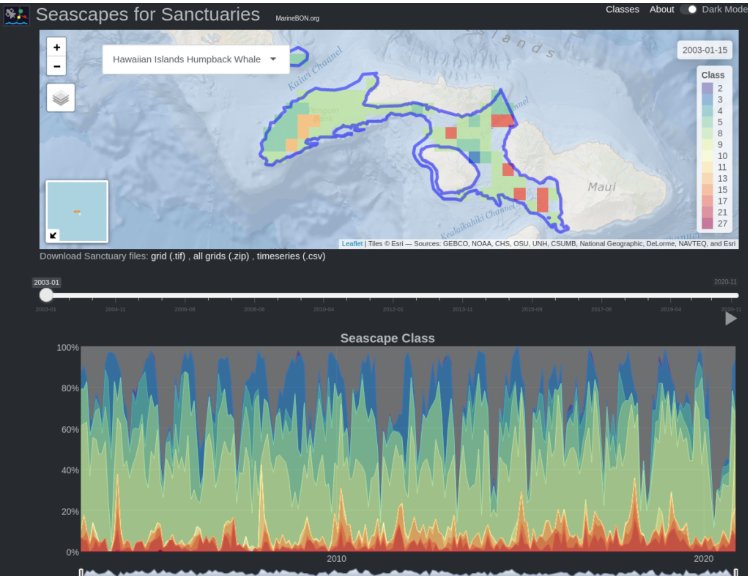BioSound Exploratory Project
Analytical Documentation
The BioSound Working Group
The BioSound working group is composed of various scientists and stakeholders interested in producing acoustic-based data products that support marine biodiversity monitoring and conservation. BioSound is particularly interested in understanding the value of underwater soundscape metrics as indicators of biological and anthropogenic change in the context of biodiversity conservation. BioSound was formed as an initiative of the Marine Biodiversity Observation Network (MBON). Additional information regarding the goals and objectives of the group can be found at the MBON BioSound site. This work was supported by the U.S. Marine Biodiversity Observation Network (MBON) co-organized by NOAA, NASA, BOEM, and ONR through the National Oceanographic Partnership Program (NOPP).
Exploratory Project
The group’s initial project begins with a focused initiative to compare acoustic-based biodiversity indices across various ocean environments, paving the way for a broader, more extensive analysis. These efforts aim to generate valuable data products highlighting biological sounds and habitat characteristics in regional ocean and coastal areas, while also providing recommendations for standardizing soundscape metric methods and enhancing standards within the bioacoustic community.
Explore the data collected during this exploratory study via our dashboard:
BioSound Data Exploration Dashboard
The analytical workflow for multiple components begins with collecting raw audio files from 8 distinct datasets. These files undergo comprehensive data management steps, including preprocessing and standardization, to enable the extraction of acoustic indices in multiple comparable ways across datasets. Additionally, annotations of vessel activity and, where feasible, organismal occurrences are integrated with environmental data to provide context for the acoustic recordings. Subsequently, the processed data are incorporated into a user-interactive dashboard designed for evaluating data across sites and indices. This dashboard facilitates comprehensive exploration and analysis, enabling researchers to gain insights into the relationships between acoustic indices, environmental factors, and biological activity across diverse marine environments. Additionally, scripts and data products obtained during this analysis are available in the Ocean Science Analytics BioSound-Exploratory-Project GitHub site.

The Datasets
The datasets utilized in this study originate from diverse environments, including offshore, mangrove, and reef ecosystems, spanning both the Pacific and Atlantic Oceans. These datasets have been contributed by members of the BioSound working group, highlighting a collaborative effort to incorporate acoustic data from various marine habitats for comprehensive analysis. Below, a map and table delineate the specific datasets employed in this study, providing geographic context and detailed information about each dataset’s characteristics.

| Dataset Name | Source | Contact | Marine Ecosystem Type | Native Sampling Rate (kHz) | Duty Cycle | Native File Duration | Selected Months |
|---|---|---|---|---|---|---|---|
| Biscayne Bay, FL | University of Miami | Neil Hammerschlag/Abby Tinari | Mangrove | 32 | 10 seconds every minute | 0:00:10 | Feb - Mar, 2019 |
| Chukchi Sea, Hanna Shoal | Oregon Sate University | Kate Stafford | Offshore | 16.384 | 25 minutes every hour | 0:25:00 | Jan - Mar, 2019 |
| Gray’s Reef, GA | NEFSC-SanctSound | Tim Rowell | Offshore | 48 | Continuous | ~5:40:00 | Jan - Feb, 2019 |
| Key West, FL | Florida Fish & Wildlife | Jessica Keller | Coral Reef | 48 | 30 seconds every five minutes | 0:00:30 | Feb - Mar, 2020 |
| May River, SC | U. of South Carolina, Beaufort | Alyssa Marian/ Eric Montie | Estuary | 80 | 2 minutes every 20 minutes | 0:02:00 | Jan - Mar, 2019 |
| Olowalu (Maui, HI) | SanctSound - Hawaiian Islands Humpback NMS | Eden Zang | Island/Nearshore | 48 | Continuous | ~5:40:00 | Jan - Feb, 2019 |
| ONC-MEF | Ocean Networks Canada | Jasper Kanes | Offshore | 64 | Continuous | 0:05:00 | Jan - Feb, 2019 |
| OOI-HYDBBA106 | Ocean Observatories Initiative | Liz Ferguson | Shelf | 64 | Continuous | 0:05:00 | Jan - Feb, 2019 |
Acoustic-based Indices
We utilized scikit-maad, a comprehensive Python package tailored for acoustic analysis, to efficiently extract acoustic-based indices from our audio recordings. Its rich set of functionalities and easy-to-use interface provided us with the necessary tools to process and analyze acoustic data, enabling robust and standardized computation of biodiversity indices. An description of all indices is available from the “Acoustic Indices” tab, and required processing is indicated in the “Data Processing & Management” tab.

Environmental Data
SeascapeR, a powerful tool developed by the Marine Biodiversity Observation Network (MBON), offers extensive capabilities for analyzing and visualizing marine habitat data. Leveraging SeascapeR, we are conducting comparative analyses between distinct water classes and acoustic indices, allowing us to explore the relationships between habitat characteristics and potential acoustic biodiversity across diverse marine environments. Combinations of remotely sensed data variables at certain thresholds are used to characterize water bodies into one of 33 Seascape Global Water Classes.

Dashboard and Documentation
Ocean Science Analytics (OSA) spearheads the analytical effort, employing advanced data analytics techniques to derive meaningful insights from diverse marine datasets. For the data compilation and visualization piece, OSA and Waveform Analytics collaborated closely on the development of an interactive dashboard, data integration, and comprehensive documentation to facilitate intuitive exploration and interpretation of the integrated acoustic and environmental data.

